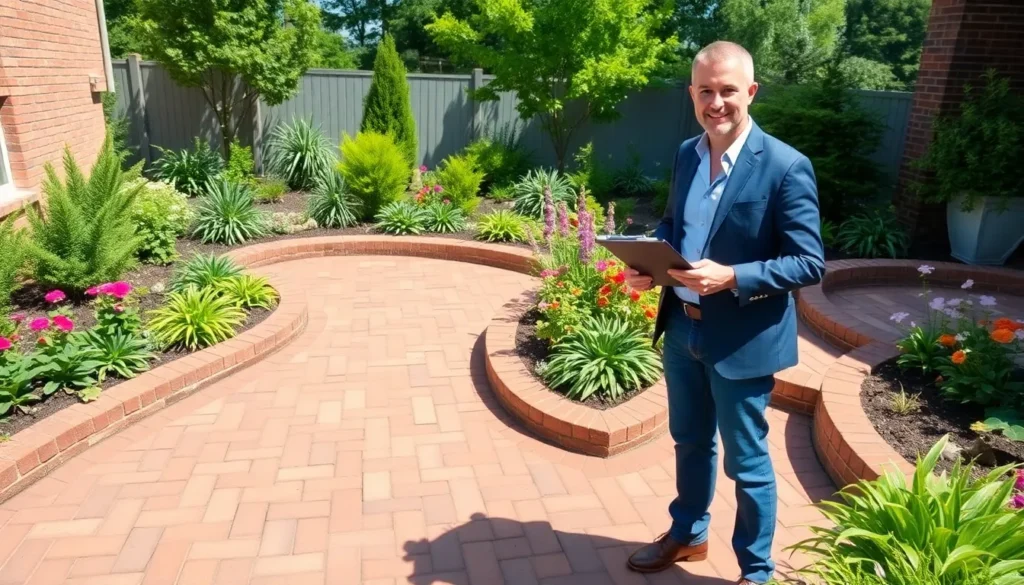Table of Contents
ToggleWhen it comes to transforming outdoor spaces into breathtaking landscapes, bricks are the unsung heroes of design. Forget flimsy wooden borders that warp and rot: bricks bring indomitable strength and timeless beauty to any garden. Why settle for boring asphalt or concrete when you can have the kind of style that makes your neighbors envious? Let’s jump into why bricks are your best bet for landscaping, and who knows, you might just become the talk of the town with your new outdoor masterpiece.
Why Choose Bricks For Landscaping

Durability and Longevity
Bricks are like that reliable friend who always shows up on time: they stand the test of time without blinking. These solid blocks are weather-resistant and can withstand various climatic conditions, from relentless sun to torrential rain. While rotting wood and cracking concrete might require regular upkeep and costs over time, bricks typically last for decades with minimal maintenance needed. Talk about a win-win.
Versatility in Design
Got a dream for a picturesque garden? Bricks can help make it a reality. Their ability to blend seamlessly with various landscaping styles, from traditional to modern, makes them exceptionally versatile. Lay bricks in different patterns, colors, or textures to achieve that eye-catching look you’ve always wanted. Whether creating winding paths or intricate patios, the possibilities are endless.
Eco-Friendliness
Bricks don’t just look good: they also love Mother Earth. Made from natural clay and minerals, they are eco-friendly, contributing to green building practices. Also, they can be repurposed and recycled, reducing waste. By choosing bricks for landscaping, it’s like giving a high-five to sustainability, aligning your outdoor project with eco-conscious values.
Types of Bricks Used in Landscaping
Clay Bricks
Clay bricks are often viewed as the classic choice for landscaping projects. Their rich, earthy tones provide a timeless appeal, and they absorb moisture, which can help with drainage. They are perfect for pathways and walls that accentuate gardens with elegance and durability.
Concrete Bricks
Concrete bricks have entered the scene, packing a punch in strength and versatility. They are less porous than clay bricks, making them ideal for stamping and coloring innovations. Homeowners often favor them for patios and driveways due to their solid construction and diverse aesthetic offerings.
Pavers vs. Regular Bricks
Confused about whether to go with pavers or regular bricks? Pavers, often interlocking, are specifically designed for heavy foot traffic and can handle the wear and tear of outdoor environments. Regular bricks, while also durable, tend to be better for decorative accents rather than primary surfaces. Knowing the difference will help streamline your choice and ensure longevity in your landscaping.
Applications of Bricks in Landscaping
Patios and Pathways
Imagine lounging on a beautiful patio that not only looks fantastic but is also built to last. With bricks, patios become a seamless extension of your indoor space, drawing family and friends outside for enjoyable gatherings. Create winding pathways that guide visitors through your garden, leading them on a journey through nature’s beauty.
Garden Borders and Edging
Want to demarcate your garden beds without looking tacky? Brick borders are here to save the day. These handy features help contain soil, prevent weed growth, and provide a neat appearance. Adding a pop of color or texture with bricks can really make your flower beds stand out.
Retaining Walls
If you’re dealing with sloping landscapes, retaining walls made from bricks can be both functional and visually appealing. They hold back soil while providing essential erosion control. Plus, they can become a statement piece in your garden, especially when stacked creatively.
Creating Raised Beds and Planters
Elevate your garden game with raised beds made from bricks. Not only do they define space beautifully, but they also improve soil drainage and warmth, making them ideal for growing vegetables and flowers. Plus, they add an architectural element that enhances your overall design.
Tips for Choosing the Right Bricks
Color and Texture Considerations
Before diving into that brick-buying frenzy, consider the aesthetics. The color and texture of bricks can dramatically alter the mood of your landscape. Earthy tones create a natural look, while brighter hues can add a playful touch. Think about how they’ll interact with existing features like plants or structures.
Size and Shape Options
Bricks come in various sizes and shapes. Wider bricks may cover more ground efficiently, while thin bricks allow for intricate designs. Playing with sizes and shapes can give your outdoor space character and personality. Think outside the box, your landscaping can be as unique as you are.
Budgeting for Your Project
Let’s talk dollars and cents. Budget plays a crucial role in your landscaping choices. Bricks can range widely in price, depending on type and quality. By setting a realistic budget early in your planning process, you can choose the best options without financial stress.
Installation Tips and Best Practices
Preparation of the Site
Before laying your bricks, prepare the site like a pro. Clear the area of debris, plants, and uneven surfaces. A level base is essential for preventing future issues such as cracking or uneven paths. You wouldn’t build a house on sand, right? The same principle applies here.
Laying Bricks for a Secure Fit
When laying bricks, method matters. Use a concrete mix or sand as a base to ensure stability. Start from a corner or edge and lay bricks tightly against each other. Experiment with patterns, but remember that straight lines are easier for first-timers.
Finishing Touches and Maintenance
After installation, finishing touches elevate the project. Filling in joints with sand or mortar ensures that bricks stay in place. Regular maintenance, such as cleaning and checking for cracks, can extend the life of your brick features. With a little care, your landscape will dazzle for years to come.




